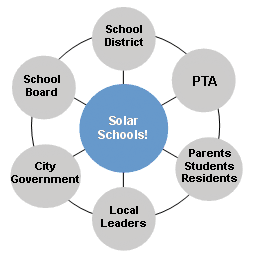Stakeholders

Each stakeholder in a HELiOS project plays an important role.
Related Content
 Addressing energy issues in your school or school district may be one of the most effective ways that you can achieve significant cost savings, improve the value of the education our children receive, and show our children that we are taking the threat of climate change seriously. Our children are looking to us to do our part. We can't afford to let them down.
Addressing energy issues in your school or school district may be one of the most effective ways that you can achieve significant cost savings, improve the value of the education our children receive, and show our children that we are taking the threat of climate change seriously. Our children are looking to us to do our part. We can't afford to let them down.
Here’s a description of the stakeholders in a typical HELiOS Project and how they can help. Any one of these stakeholders can be the catalyst for a local HELiOS project.
School Districts
School superintendents and their staff carry a huge responsibility to assure that they provide the best education possible for our children. Energy use and its cost have generally been low priorities for school administrations, especially since electricity and heating costs were relatively modest components of a District’s overall operating budget. That is no longer the case. The combination of rising energy costs and constrained District budgets have now focused everyone’s attention on ways to reduce spending on energy.
Our HELiOS model shows that you can reduce energy consumption and add renewable energy systems (e.g., solar panels) without increasing a District’s operating expenses. Many school districts are looking very closely at the 3 "E"s – energy conservation, energy efficiency, and energy from renewable sources – as an approach to reducing operating expenses and as a future source of revenue once the solar energy systems are amortized.
School Boards
School Board members are well situated to be advocates for better energy policy. School Boards are faced with extraordinary challenges in developing budgets that provide the people and tools needed to give our children the best education possible, but they are constrained by rising costs, aging infrastructure, and increasing enrollment rates.
One sure way to save money is by reducing energy consumption in existing buildings, and also by building and modernizing schools with renewable energy systems. The Alliance to Save Energy estimates that school districts spend more money on energy than is spent on computers and textbooks combined. In California, the Bright Schools Program provides funding to help school districts identify and implement energy savings. Low-interest loans are also available from the state to implement the identified energy saving technologies and for the installation of renewable energy systems.
Parent-Teacher Associations (PTAs)
PTAs represent the largest vountary child advocacy association in the US. They work diligently at the federal, state, and local levels to assure that the best interests of our children are always placed first. It's becoming increasingly clear that our children's futures are at risk from the unprecedented changes that are occurring to the planet as a result of the increasing amounts of carbon emissions that are entering the atmosphere. PTAs can play an important role by encouraging school principals, district administrators, and local community and political leaders to support "3 E" efforts in local schools.
Parents, Residents, and Students
Parents can promote better energy management in our schools in many ways. Supporting their children’s school advocacy efforts, introducing the HELiOS model to the school’s PTA, teachers, and Principal, encouraging energy conservation behaviors at home and at school, and supporting the District’s efforts to raise bond funding or property taxes to cover the cost of renewables are actions that can put schools on a path to minimizing their use of fossil-fuel-generated electricity and starting to produce energy from clean and renewable sources.
High school students in particular have been early and powerful motivators in getting their school districts to consider the installation of on-campus renewable energy systems. As the face of the future, their presence and advocacy advance the discussion about energy conservation, better energy efficiencies, and renewable systems in schools. Students can also help to change energy use behaviors in their own schools, create fun and competitive activities to raise awareness, and reduce energy consumption among their peers and families.
Residents who have expertise in the areas of finance, architecture, solar installation, energy efficiency, and advocacy are welcome participants in assisting their school districts to appreciate the value of implementing the "3 E's" and in helping their school districts fill in knowledge and experience gaps.
Local Community Leaders
Local community leaders bring together a cross-section of community participants and encourage them to work together collaboratively while maintaining a positive can-do attitude. The primary obstacle to the success of a HELiOS project is often one of attitude, so ensuring that all participants work together – embracing obstacles as challenges to be overcome – is a key characteristic of exemplary community leadership.
City Government
In California, local government and the local school district are generally two separate entities with their own governance mechanisms and budgets. Nevertheless, the growing concern about climate change and the awareness of the role local government can play in reducing greenhouse gas emissions, is giving local government a reason to work more closely with the city's school districts. See ICLEI USA for more information on how local governments can reduce their carbon emissions.
Local governments can work with school districts to share their expertise in energy management and waste reduction strategies, and help conduct assessments to determine the energy generation potential of schools and municipal facilities. This type of support is helpful for planning purposes, future funding opportunities, and efforts to reduce overall carbon emissions generated by public facilities.

